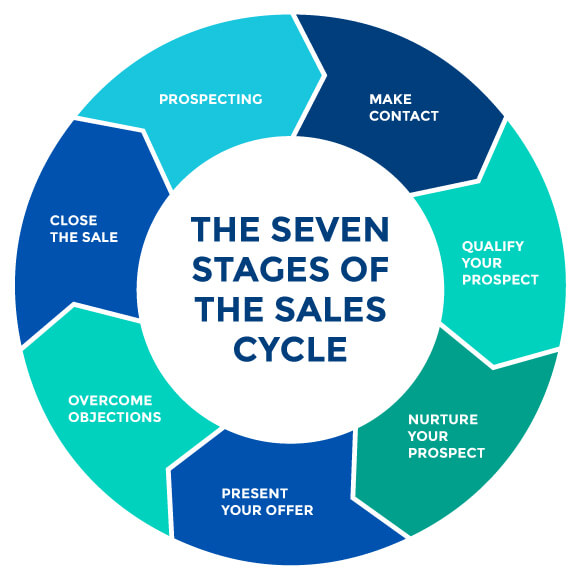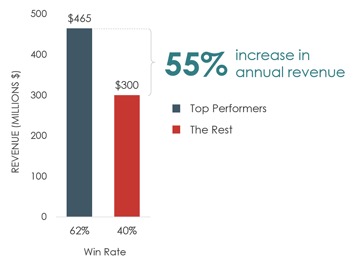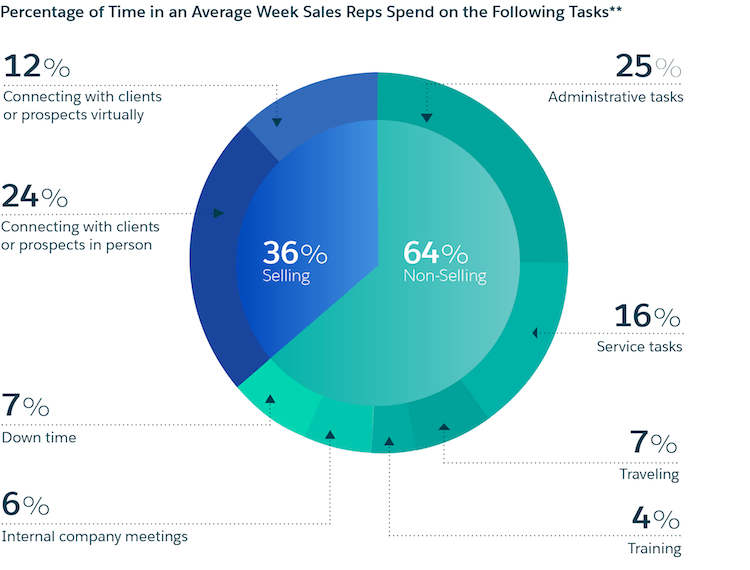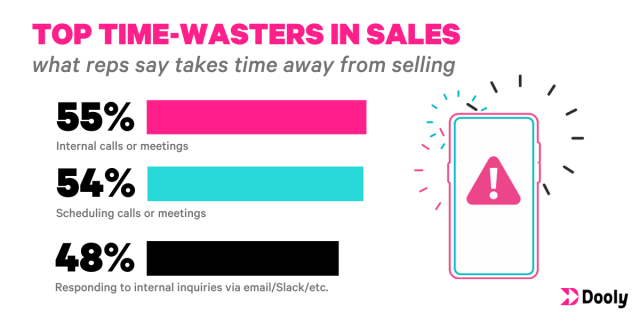How to Measure and Boost Your Sales Team Efficiency

Your sales team is the lifeblood of your business. But keeping them working at maximum efficiency can be a tricky balancing act. In fact, 40% of companies missed their sales targets in 2020.
So what is the secret sauce that keeps your business out of this statistic? It all comes down to efficiency and how well your sales team uses their time and resources to close deals.
Your sales team needs to be as efficient as possible in today’s competitive global marketplace. Don’t let your best salespeople fall behind by not being proactive and taking the right steps to measure sales performance, identify bottlenecks in your workflows, and establish a plan to increase sales productivity.
In this post, you’ll learn the ten best metrics for measuring sales and the best practices to boost sales team efficiency for driving long-term business growth.
Let’s dive in.
What is sales team efficiency?
Efficiency measures how well your sales team uses their time and resources to complete sales tasks. Because it’s such an essential metric, you should have a system in place that measures efficiency regularly. Being proactive will help you identify the strengths and weaknesses of your organization so you can make the necessary adjustments as needed.
You can calculate efficiency in several ways, but one common method is value-added analyses (or VAA). VAA calculates how much each customer interaction is worth to the salesperson. This is based on how close it is to the final sale and what stage of the sales process it’s in.
For example: If it took two hours for a representative to get a client to sign on for $500 worth of services, then 60% of that time would be considered “value added.” The remaining 40% would be considered “non-value added” because it didn’t directly contribute toward closing that sale.
Another way to measure efficiency is by identifying all the key factors that influence it.
- Efficiency: The ratio of revenue your business generates compared to the total cost of running your business. It measures how well you use your assets and resources to generate profit.
- Productivity: The measure of how much output or work gets done per unit of input — it’s a ratio based on units produced versus time spent or other factors involved in getting those units made. In this case, “units” could mean anything from couches to software or services sold (and so forth).
- Activity: An indicator of how much work was completed by employees over a set period. Activity can be expressed as “hours worked.” For example: If two sales reps spent eight hours each working on sales campaigns over one month, their activity levels are 16 hours worked (8 hours * 2 sales reps = 16 hours).
Apart from this, you can leverage the Performance management tool to get a better understanding of your sales team’s efficiency. It will help you evaluate how each team member is progressing and the status of their current strengths and weaknesses.
10 Metrics to Measure Sales Team Efficiency
Feeling overwhelmed? Don’t worry.
Here are some basic sales metrics you can use to get an idea of how well your sales reps are doing. Depending on your organization’s goals and needs, some of these metrics may be more important than others.
Let’s take a closer look at metrics to measure your sales team’s efficiency. Keep in mind these metrics also have a direct impact on your business growth and profitability:
1. Total revenue
Total revenue is one of the most important metrics to measure sales team efficiency. This metric helps you understand how much money your company has brought in and it can help you identify potential problems with your sales team’s performance.
Utilizing performance management software for measuring this metric can not only help you understand how much money your company has brought in but also enables you to identify potential problems with your sales team’s performance. By analyzing the data provided by the performance management software, you can pinpoint any bottlenecks within your sales process that may be hindering revenue generation.
If there are no sales coming in the door, that’s a clear indicator that there is a bottleneck somewhere in your sales process that needs attention.
2. Revenue by market or product
To help you further identify winners and losers, break down your revenue into different segments. Of course, this breakdown will depend on the type of product or service you offer.
For example, HelloRache provides virtual healthcare assistant services across medical, dental, and veterinary offices. In this case, they’d segment their revenue by the healthcare sector.
On the other hand, Infinity Dish segments its audience based on satellite TV packages, with English, Latin, Sports, International, and Business options. So, for optimal results, they track revenue by the type of buyer persona to whom each service is targeted.
If you want to understand your revenue better, break your data down into smaller pieces. This will help you see which products or markets need more attention. This metric has a direct relation with your business growth. If you want to see the breakdown of your revenue by marketing channel, use a tool like Salesforce and Google Analytics integration to bring your sales and marketing data together
3. The average length of the sales cycle
The average length of a sales cycle tells you how long it takes to close a deal.
It’s important to measure this metric because it helps you understand how long customers are taking to make decisions about your product, and it can be used to establish benchmarks and goals for future sales cycles.
If you don’t know your average sales cycle, you won’t be able to tell if you’re falling behind or making progress. If your average is getting shorter, then you’re doing something right.
But if it’s getting longer, then maybe it’s time to rethink some things, and it could indicate that your pitch isn’t compelling enough, the quality of your leads is poor, or your product isn’t worth the price.
After closing the sale, however, you need to focus on maintaining stellar CX, which starts with the first part of post-sales; Invoice.
Make sure to create an Invoice using an online invoice generator or use Google Sheets templates, set up invoice reminders, and use your sales experts to maintain regular communication with your clients to provide anything they need.
This will help improve their satisfaction and will, therefore, improve your retention rate.
Consider using invoice templates that can streamline your billing process and ensure consistency in your communication with clients.
4. Year-over-year growth
Year-over-year (YOY) growth is best for showing the performance of high-level execution strategies and whether you are achieving your long-term growth goals.
Of course, you can track sales performance over any period, including monthly or quarterly.
Assuming that your revenue for 2022 is $150 million and the revenue for 2021 was $50 million, the formula for calculating YOY growth is:
[($150 million – $50 million) / $50 million] * 100 = 200% YOY growth
YoY growth is also a key indicator of the overall performance of your sales team. Many agile coaches use YoY data to increase sales productivity and motivate sales representatives to achieve their goals.
5. Win rate
One of the most common ways to measure your sales team’s efficiency is their win rate or how often they close deals. You can calculate the win rate by dividing the number of deals closed by the total number of opportunities pursued.
For example: If you closed 10 deals with 20 prospects during a month, your win rate is 50%. Increasing your win rate is a surefire way to grow sales without hiring more headcount.
6. Revenue percentage from new vs. existing customers
Utilizing revenue enablement strategies is essential for understanding how your sales team is performing. Breaking up your revenue by customer type is a great way to see how your sales team is doing to bring in new business. If you have more revenue coming from existing customers than new ones, you’re probably having trouble finding new clients or closing deals.
Also, up-selling or cross-selling to existing customers is an easy way to capture low-hanging fruit. Your chances of selling to a customer you already have are 60–70%, while your chances of selling to a new customer are only 5–20%.
7. Call-to-activity ratio
The call-to-activity ratio is a sales metric that measures the number of calls your team makes to the number of activities completed. Activities include emails, meetings, and other tasks that are part of your sales process. It’s a good way to measure how busy your entire sales team is at any given time.
For example, if you have five reps who make 20 calls each and 10 activities each, then the ratio would be 4:1 (20/10), which means that those reps are only completing four out of every five calls they make. The data shows that they’re probably not spending enough time on the other tasks necessary for them to hit their quotas.
However, this doesn’t mean they should spend excessive time on tasks that can be automated, like taking notes or dialing numbers manually. These metrics can help you identify areas for improvement in your workflow by adopting AI features and tools like a power dialer to save time and increase efficiency.
8. Number of sales meetings per week
Measuring the number of weekly sales meetings and the average length of those meetings is an important indicator of your overall sales process efficiency. If you have a lot of leads coming in through an email finder tool but not many appointments are being booked, your team may not be spending enough time on each call.
Contact dFind out kfata software like UpLead or ZoomInfo can help you enrich your lead data so your team has more information about these prospects upfront. Find more Uplead and ZoomInfo competitors.
If your staff members are averaging three or four new prospect meetings per week and — and yet only booking half of those leads — it may indicate that either: your team isn’t scheduling enough appointments with the right leads or something is going wrong in the meeting.
If this metric is low or stagnant, there’s room for improvement in how efficiently your team works together towards goals like booking more discovery calls.
9. Average call length
You can get a good idea of your sales team’s efficiency by looking at the average call length, which is simply the average amount of time it takes for a sales rep to complete a sales call.
Average call length varies depending on several factors, such as:
- Sales representative: Each salesperson will have their style and way of working with customers, so their average calls will vary from one another.
- Product or service sold: Different products and services require more or less attention than others to close deals successfully — this is why they’ll have different average call lengths than other products or services within your product line-up.
- Lead source: A lead source can impact how quickly your sales reps can close a deal. Suppose they’re not sourcing high-quality leads that are ready to buy right now. If selling to qualified prospects, they’ll likely only need a short conversation to close the deal than if selling to people who need more convincing and haven’t heard of your offerings before.
10. Prospecting time per week
Prospecting time per week is a metric that shows how much time your sales team spends building leads.
If a sales rep isn’t spending enough time prospecting, they could miss potential opportunities or even fail to qualify leads properly. This means that the next step in the sales cycle will take longer than necessary, eventually wasting more time and resources on unsuccessful attempts at closing deals.
5 Ways to Improve Sales Team Efficiency
Now that you know how to measure your sales team efficiency, what if you are unsatisfied with the results?
Consider a few of these insights to help boost sales team efficiency and land more sales.
1. Focus on the right metrics
The sales world is full of hundreds of metrics and key performance indicators (KPIs). It can be easy to get lost in the sea of sales jargon. Find a few key metrics that work for you and stick to them.
There’s no one-size-fits-all approach to measuring success. You might start by measuring sales effectiveness or the quality of leads. After all, improving sales efficiencies doesn’t matter if no sales are coming through the door.
To build a solid foundation for prospecting and lead generation, consider leveraging the power of automated lead generation solutions before switching gears to focus on sales efficiency.
Sales effectiveness metrics can help you understand how well your sales team converts qualified leads into closed opportunities. Or expose that your follow-up tactics with prospects need improving.
Once you have the sales effectiveness metrics under control, you can dive deeper into sales efficiency metrics and measure the time it takes to convert a lead into a sale.
Don’t spread yourself too thin at the start. Focus on one area to make sure things are running smoothly and then move on to the next metric or the next step in the sales cycle.
2. Automate your sales process
According to Salesforce, sales reps spend 64% of their time on non-selling tasks during the week. This is a staggering amount of time wasted when they could be bringing in more sales.
High-performing sales teams use three times more sales technology than underperforming teams.
For instance, implementing advanced sales prospecting tools can provide these teams with the necessary insights and capabilities to identify and engage potential leads effectively, contributing to their overall success in driving conversions and revenue.
With the right software, you can automate a lot of your sales process, including:
- Setting up automated reminders for follow-up calls and emails
- Automatically tracking leads as they move through the funnel
- Assigning prospects to the right sales reps
- Scheduling client meetings
Sales technology, like customer relationship management (CRM) or lead scoring software, helps improve sales team efficiency by automating busy work and reducing manual errors.
The key here is that you’re simplifying the process so that people don’t have to worry about finding time in their day for these administrative or service tasks — they can focus instead on doing what only humans can do: building relationships with customers and prospects.
3. Provide proper sales training and coaching
To achieve the necessary level of sales efficiency, you should establish a proper training program for your sales team.
Investing in training management software can help ensure that your sales team is properly trained, as it helps you plan, deliver, and track your training activities.
Sales enablement, encompassing tools, sales training, and online coaching, is a crucial part of any business. It’s a simple concept: the more you know about something, the better you’ll be able to sell it. If you have confidence in your product or service knowledge, you’ll be more compelling during the sales process.
Sales training can help you improve your company’s sales by giving employees a better understanding of what they’re selling and how to sell it. This, in turn, helps them connect with customers, establish themselves as experts, and add conviction to the sales pitch.
But it’s not just learning more about your product or service — it also includes learning about human behavior and creating relationships, which can usually make or break sales.
4. Limit unnecessary internal meetings
Another strategy that can help to improve your team’s efficiency is rethinking how you use meetings and other face-to-face interactions internally.
Meetings are a significant waste of time, money, and resources. They’re also a drain on your people’s energy levels and productivity. Here’s why:
- Meetings are unproductive because they’re often poorly planned, poorly executed, and lack focus.
- Meetings are too long and interrupt productive blocks of focus.
- Meetings are often unnecessary, and you may be able to accomplish the same goals through means like an email.
If your salespeople spend too much time in internal meetings, they’re not making sales. Consider if weekly meetings are truly necessary before scheduling them with your team. Make sure they have enough time to get out there and interact with customers through more sales meetings.
5. Implement an incentive program
Incentives are an effective way to get employees to perform better at work. You can use incentives in various ways, including monetary and non-monetary rewards. (our friends from Fineawards make custom awards, trophies & plaques)
The most common types of incentives are performance-based, where employees receive payment for meeting certain goals or exceeding expectations. For example, if you want your team members to sell more products than last year, you could offer them a bonus if they reach their quota.
Alternatively, you can reward employees who go above and beyond their quota with a trip somewhere, fun or other perks that make it clear that you appreciate what they do. A sales incentive trip is equally a great reward, a chance for top-performers to relax and recharge their batteries, and an opportunity for recognition by upper management.
Everyone loves rewards, especially after putting in a lot of hard work. The effectiveness of incentives and how they motivate people might surprise you.
Wrapping up
There are various ways to quantify how efficient your sales team is. And by going through the process, whether with these ten metrics or a few others, you can finally understand where your team is thriving and where you could use some work.
But remember, the goal isn’t just to measure sales performance but to understand what those numbers mean and how to improve them. With these five tips, you’ll be on your way to improving your sales team’s efficiency by getting more done in less time.
Automating your sales process with technology and having fewer meetings will free up time to build relationships with clients and qualify more leads. It’s time to say goodbye to wasted time and hello to more sales.










